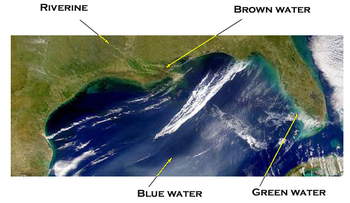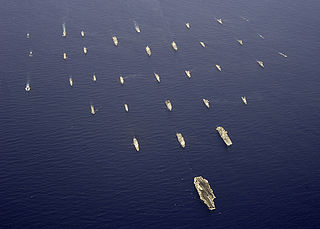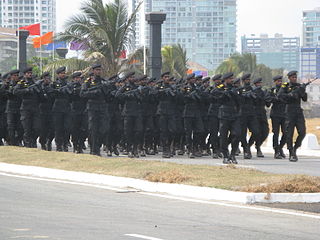
Maritime geography is a collection of terms used by naval military units to loosely define three maritime regions: brown water, green water, and blue water.

Maritime geography is a collection of terms used by naval military units to loosely define three maritime regions: brown water, green water, and blue water.
The elements of maritime geography are loosely defined and their meanings have changed throughout history. The USA's 2010 Naval Operations Concept defines blue water as "the open ocean", green water as "coastal waters, ports and harbors", and brown water as "navigable rivers and their estuaries". [1] Robert Rubel of the US Naval War College includes bays in his definition of brown water, [2] and in the past US military commentators have extended brown water out to 100 nautical miles (190 km) from shore. [3]
During the Cold War, green water denoted those areas of ocean in which naval forces might encounter land-based aircraft and brown water, land-based artillery. [2] The development of long-range bombers with antiship missiles turned most of the oceans to "green" and the term all but disappeared. [2] After the Cold War, US amphibious taskforces were sometimes referred to as the green-water navy, in contrast to the blue-water carrier battlegroups. [4] This distinction disappeared as increasing threats in coastal waters forced the amphibious ships further offshore, delivering assaults by helicopter and tiltrotor from over the horizon. This prompted the development of ships designed to operate in such waters - the Zumwalt class destroyer and the littoral combat ships. Rubel has proposed redefining green water as those areas of ocean which are too dangerous for high-value units, requiring offensive power to be dispersed into smaller vessels such as submarines that can use stealth and other characteristics to survive. [2] Under his scheme brown water would be zones in which ocean-going units could not operate at all, including rivers, minefields, straits and other choke points. [2]
The brown water environment starts from the shoreline through to the end of the continental shelf. A brown-water navy focuses on coastal operations and primarily takes a defensive role. "Brown water" or "brown ocean" is also used by meteorologists to refer to intertidal wetlands where the border between the ocean and dry land is not clear-cut.
The green water environment extends from the outer edge of the brown-water layer past any continental shelves, archipelagos and islands; perhaps a few hundred miles from shore. It is the most important maritime arena, including most coastal traffic and territorial waters, in which are found the great majority of a nation's maritime police, customs, environmental, and economic concerns. A green-water navy is capable of defense of its nation in depth and is a significant offensive force within its territory.
The blue water environment extends from the outer edge of the green-water zone to the deep ocean of the world. A blue-water navy can project its nation's power throughout the world. The blue water policy was a long-standing political philosophy in Britain in the 18th century, which sought to advance British power through use of the Royal Navy, although the term "blue water" did not appear until 1834. [5]

A navy, naval force, or maritime force is the branch of a nation's armed forces principally designated for naval and amphibious warfare; namely, lake-borne, riverine, littoral, or ocean-borne combat operations and related functions. It includes anything conducted by surface ships, amphibious ships, submarines, and seaborne aviation, as well as ancillary support, communications, training, and other fields. The strategic offensive role of a navy is projection of force into areas beyond a country's shores. The strategic defensive purpose of a navy is to frustrate seaborne projection-of-force by enemies. The strategic task of the navy also may incorporate nuclear deterrence by use of submarine-launched ballistic missiles. Naval operations can be broadly divided between riverine and littoral applications, open-ocean applications, and something in between, although these distinctions are more about strategic scope than tactical or operational division.

The People's Liberation Army Navy, also known as the People's Navy, Chinese Navy, or PLA Navy, is the maritime service branch of the People's Liberation Army.

The Royal New Zealand Navy is the maritime arm of the New Zealand Defence Force. The fleet currently consists of nine ships. The Navy had its origins in the Naval Defence Act 1913, and the subsequent purchase of the cruiser HMS Philomel, which by 1921 had been moored in Auckland as a training ship. A slow buildup occurred during the Interwar period, and then perhaps the infant Navy's finest hour occurred soon after the beginning of World War II when HMS Achilles fought alongside two other Royal Navy cruisers at the Battle of the River Plate in December 1939.

The littoral zone or nearshore is the part of a sea, lake, or river that is close to the shore. In coastal ecology, the littoral zone includes the intertidal zone extending from the high water mark to coastal areas that are permanently submerged — known as the foreshore — and the terms are often used interchangeably. However, the geographical meaning of littoral zone extends well beyond the intertidal zone to include all neritic waters within the bounds of continental shelves.

A fleet or naval fleet is a large formation of warships – the largest formation in any navy – controlled by one leader. A fleet at sea is the direct equivalent of an army on land.

The United States Naval Special Warfare Command (USNSWC), also known as, is the naval component of United States Special Operations Command, the unified command responsible for overseeing and conducting the nation's special operations and missions.

The term brown-water navy or riverine navy refers in its broadest sense to any naval force capable of military operations in littoral zone waters. The term originated in the United States Navy during the American Civil War, when it referred to Union forces patrolling the muddy Mississippi River, and has since been used to describe the small gunboats and patrol boats commonly used in rivers, along with the larger "mother ships" that supported them. These mother ships include converted World War II-era Landing Crafts and Tank Landing Ships, among other vessels.

The Republic of Singapore Navy (RSN) is the naval service branch of the Singapore Armed Forces (SAF) responsible for the defence of Singapore against sea-borne threats and protection of its sea lines of communications. The service was formally established in 1967 and has since undergone a substantial modernisation.

A blue-water navy is a maritime force capable of operating globally, essentially across the deep waters of open oceans. While definitions of what actually constitutes such a force vary, there is a requirement for the ability to exercise sea control at long range.

Command of the sea is a naval military concept regarding the strength of a particular navy to a specific naval area it controls. A navy has command of the sea when it is so strong that its rivals cannot attack it directly. This dominance may apply to its surrounding waters or may extend far into the oceans, meaning the country has a blue-water navy. It is the naval equivalent of air supremacy.
The Force d'action navale is the 9,600-man and about 100-ship force of surface warships of the French Navy. As of 2018, it is commanded by Vice-Amiral d’Escadre Jean-Philippe Rolland.

Marines, or naval infantry, are typically a military force trained to operate in littoral zones in support of naval operations. Historically, tasks undertaken by marines have included helping maintain discipline and order aboard the ship, the boarding of vessels during combat or capture of prize ships, and providing manpower for raiding ashore in support of the naval objectives. In most countries, the marines are an integral part of that state's navy.

A green-water navy is a maritime force that is capable of operating in its nation's littoral zones and has limited competency to operate in the surrounding marginal seas. It is a relatively new term, and has been created to better distinguish, and add nuance, between two long-standing descriptors: blue-water navy and brown-water navy.

The Sri Lanka Navy (SLN) is the naval arm of the Sri Lanka Armed Forces and is classed as the country's most vital defence force due to its island geography and is responsible for the maritime defense of the Sri Lankan nation and its interests. The role of the Sri Lanka Navy is to conduct operations at sea for the defence of the nation and its interests and conduct prompt and sustainable combat operations at sea in accordance with the national policies.

Navy Expeditionary Combat Command (NECC) serves as the single functional command to centrally manage current and future readiness, resources, manning, training and equipping of the United States Navy's 21,000 expeditionary forces who are currently serving in every theater of operation. The NECC was established in January 2006. NECC is a subordinate command of the Navy's Fleet Forces Command.
The structure of the United States Navy consists of four main bodies: the Office of the Secretary of the Navy, the Office of the Chief of Naval Operations, the operating forces, and the Shore Establishment.

The Special Boat Squadron is the Sri Lanka Navy's elite special forces unit, modeled after the British Special Boat Service. It was raised in 1993 and fought in the Sri Lankan Civil War.

The United Arab Emirates Navy is the naval branch of the United Arab Emirates Armed Forces. It is small force of about 3,000 personnel. It maintains 12 well-equipped coastal patrol boats and eight missile boats. Although primarily concerned with coastal defense, the Navy is constructing a six-unit class of blue water corvettes in conjunction with French shipbuilder CMN. The UAE maintains a small battalion-sized marine force called the UAE Marines equipped with BMP-3 armoured personnel carriers.

The United States Navy (USN) is the maritime service branch of the United States Armed Forces and one of the eight uniformed services of the United States. It is the largest and most powerful navy in the world, with the estimated tonnage of its active battle fleet alone exceeding the next 13 navies combined, including 11 allies or partner nations of the United States as of 2015. It has the highest combined battle fleet tonnage and the world's largest aircraft carrier fleet, with eleven in service, two new carriers under construction, and five other carriers planned. With 336,978 personnel on active duty and 101,583 in the Ready Reserve, the United States Navy is the third largest of the United States military service branches in terms of personnel. It has 290 deployable combat vessels and more than 2,623 operational aircraft as of June 2019.
Underwater domain awareness (UDA) is the aspect of maritime domain awareness focused on the underwater sector, including, from a security perspective, sea lines of communication (SLOC), coastal waters and varied maritime assets with reference to hostile intent and the proliferation of submarine and mine capabilities intended to limit access to the seas and littoral waters. The military requirement is not the only motivation for undersea domain awareness. The earth's undersea geophysical activities as they relate to the well-being of humans is also relevant, as monitoring such activities can provide vital clues to minimize the impact of devastating natural disasters.